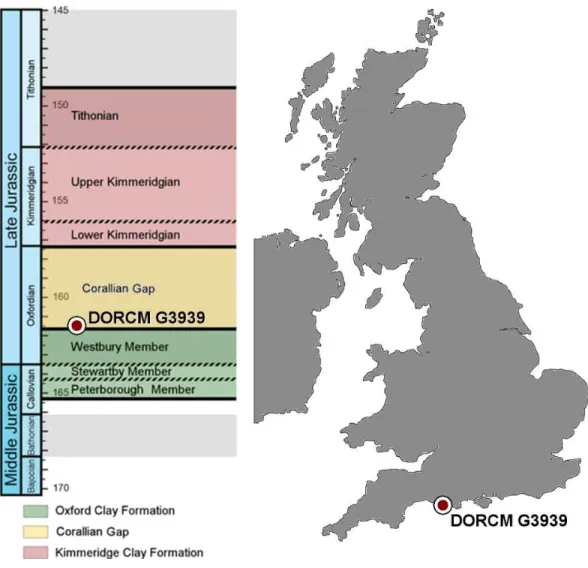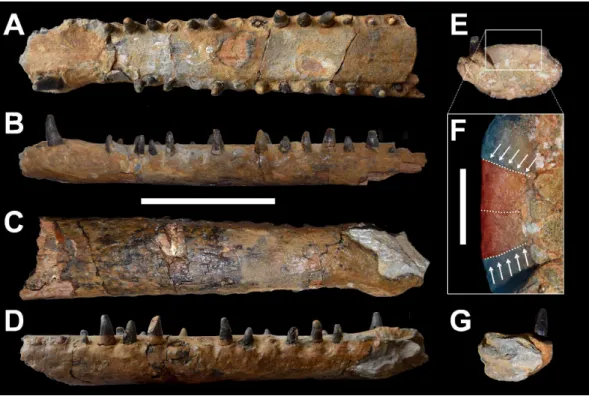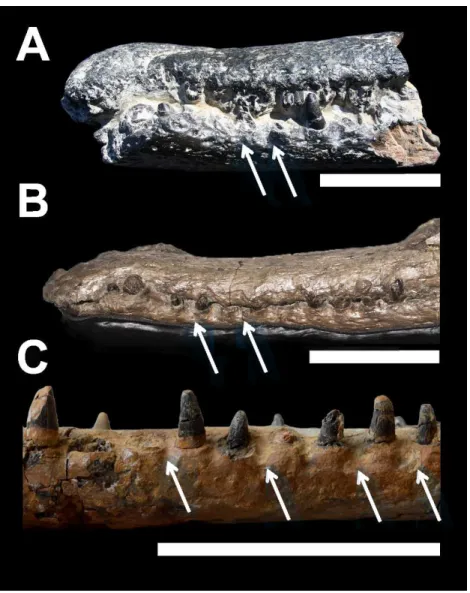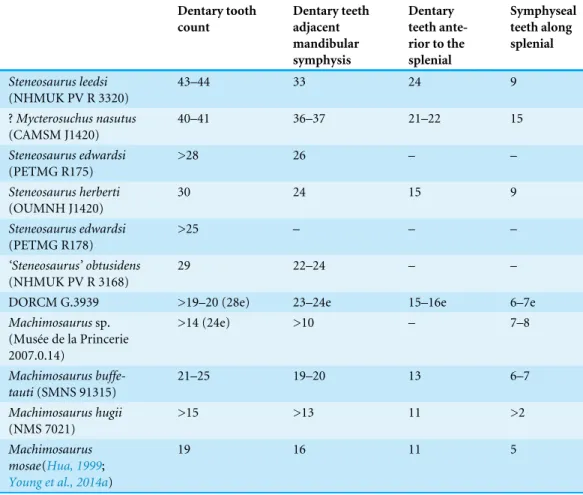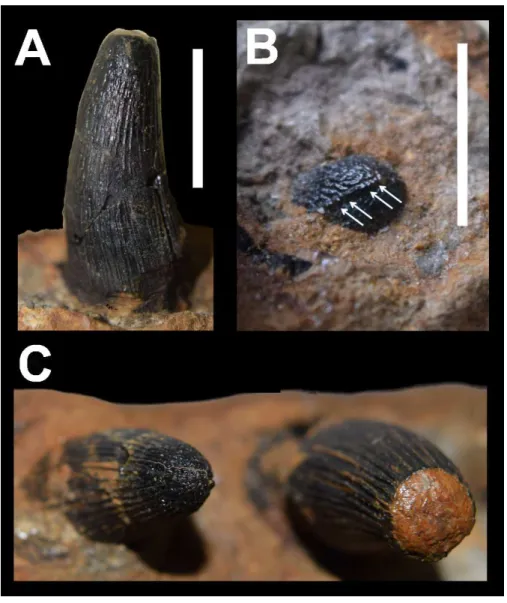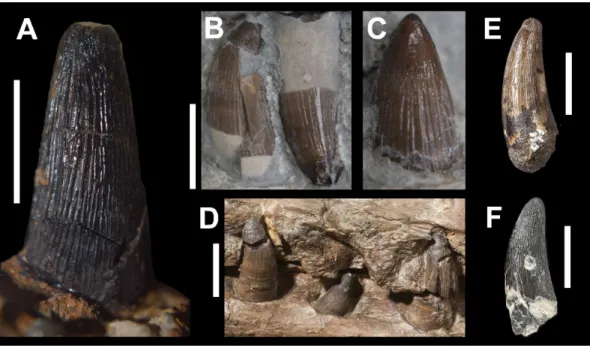Submitted4 November 2015 Accepted 23 November 2015 Published17 December 2015
Corresponding author
Davide Foffa, davidefoffa@gmail.com
Academic editor Jérémy Anquetin
Additional Information and Declarations can be found on page 13
DOI10.7717/peerj.1497
Copyright 2015 Foffa et al.
Distributed under
Creative Commons CC-BY 4.0
OPEN ACCESS
Evidence of macrophagous teleosaurid
crocodylomorphs in the Corallian Group
(Oxfordian, Late Jurassic) of the UK
Davide Foffa1, Mark T. Young1,2and Stephen L. Brusatte1
1School of GeoSciences, University of Edinburgh, Edinburgh, United Kingdom 2Ocean and Earth Science, University of Southampton, Southampton, United Kingdom
ABSTRACT
Teleosaurids were a group of semi-aquatic crocodylomorphs with a fossil record that spanned the Jurassic Period. In the UK, abundant specimens are known from the Oxford Clay Formation (OCF, Callovian to lower Oxfordian), but are very rare in the Kimmeridge Clay Formation (KCF, Kimmeridgian to lower Tithonian), despite their abundance in some contemporaneous deposits in continental Europe. Unfortunately, due to the paucity of material from the intermediate ‘Corallian Gap’ (middle to upper Oxfordian), we lack an understanding of how and why teleosaurid taxic abundance and diversity declined from the OCF to the KCF. The recognition of an incomplete teleosaurid lower jaw from the Corallian of Weymouth (Dorset, UK) begins to rectify this. The vertically oriented dentition, blunt tooth apices, intense enamel ornamentation that shifts to an anastomosed pattern apically, and deep reception pits on the dentary unambiguously demonstrates the affinity of this specimen with
an unnamed sub-clade of macrophagous/durophagous teleosaurids (‘Steneosaurus’
obtusidens+Machimosaurus). The high symphyseal tooth count allows us to exclude
the specimen fromM. hugiiandM. mosae, but in absence of more diagnostic material
we cannot unambiguously assign DORCM G.3939 to a more specific level. Nevertheless, this specimen represents the first mandibular material referable to Teleosauridae from the poorly sampled middle-upper Oxfordian time-span in the UK.
SubjectsPaleontology, Taxonomy, Zoology
Keywords Steneosaurus, Machimosaurus, Thalattosuchia, Corallian Gap, Teleosauridae
INTRODUCTION
Teleosauridae (Thalattosuchia: Crocodylomorpha) was a group of crocodylomorphs that inhabited lagoonal/coastal environments in the Jurassic (Andrews, 1909;Andrews, 1913;
Buffetaut, 1982;Vignaud, 1995;Young et al., 2014a). During the late Middle and Late Jurassic a group of teleosaurids achieved large body sizes, heavily built skulls and blunt dentition indicative of a derived macrophagous feeding habit (Young et al., 2014a;Young et al., 2014b;Young et al., 2015a). This group includes‘Steneosaurus’ obtusidensfrom the
Oxford Clay Formation of England (Callovian) and the genusMachimosaurusfrom the
late Oxfordian to Tithonian of Europe and Africa (Sauvage, 1897–98;Hua et al., 1994;
Machimosaurusin the upper Oxfordian is based on isolated tooth crowns from France and Portugal, and a partial lower jaw (Musée de la Princerie (Verdun, France), 2007.0.14) from France (Sauvage, 1897–98;Hua, 1996;Lepage et al., 2008;Young et al., 2014a;Young et al., 2014b). None of these specimens was found to be diagnostic at the specific level and
they were referred toMachimosaurussp. based on low tooth count (estimated as lower
than‘S.’ obtusidens—see ‘Discussion’) and characters of the posterior mandible, which unfortunately cannot be assessed based upon the available‘S.’ obtusidensspecimens.
The content of the genusMachimosaurus(sensuYoung et al., 2014a) has been
ques-tioned by Martin and colleagues(2015). They considerMa. hugiithe only valid species withinMachimosaurus(Martin & Vincent, 2013;Martin, Vincent & Falconnet, 2015). However, it should be noted that Martin and colleagues did not actually address the monospecifity withinMachimosaurusas they focused on the validity ofMa. buffetauti. They suggest that this taxon is the same asMa. mosae, and both should be referred to
Ma. hugiias originally proposed byMartin & Vincent (2013). Their argument for the
synonymy betweenMa. buffetautiandMa. mosaeis based on the fact that the diagnoses
produced byYoung et al. (2014a)andYoung et al. (2015b)to distinguish these two taxa would be either accountable for intra-specific variation or by post-mortem deformation on the specimens. We recognise that the specimens have undergone some deformation (as is the norm for fossil specimens); however, we disagree with Martin and colleagues conclusions and consider these differences true morphological traits—perhaps due to
differing perception of morphological species. However,Machimosaurusspecies (sensu
Young et al., 2014a) still differ from each other in stratigraphic occurrence, basioccipital apophysis cross-section, relative size and shape of the basioccipital tuberosities, relative size of the paroccipital processes and the expansion at their lateral ends, tooth morphol-ogy, tooth enamel surface morpholmorphol-ogy, and tooth count (exceeding modern crocodylian intra-specific variationLarson, 2013;Brown et al., 2015)). Perhaps more importantly, it
should also be noted that the supposed synonymy ofMa. buffetautiandMa. mosaedoes
not prove the monospecificity of the genusMachimosaurus. Whilst Martin and colleagues
appeal to the arguments proposed inMartin & Vincent (2013), the updated diagnosis that
Young et al. (2014a)andYoung et al. (2015b)proposed forMa. hugiitype species, and the unique tooth enamel morphology of the species (Young et al., 2014b), was not taken into account inMartin, Vincent & Falconnet (2015). Consequently, we do not findMartin, Vincent & Falconnet (2015)arguments to be compelling; as such we assert the taxonomic content ofMachimosaurusas described inYoung et al. (2014a)andYoung et al. (2015b)to be valid and adopted it as phylogenetic framework in this paper.
Nevertheless, after a long debate, recent studies agree in consideringMachimosaurus
and‘Steneosaurus’ obtusidensmorphologically distinct taxa (Martin & Vincent, 2013;
Young et al., 2014a;Young et al., 2014b;Young et al., 2015a), which we agree with. Working under this assumption means that there is a significant gap separating ‘Ste-neosaurus’ obtusidensand the first unambiguousMachimosaurusspecies. This time-span roughly corresponds with the Oxfordian stage, which in the UK is represented by a series of formations stacked in between the fossil-rich Oxford Clay Formation
of the British Oxfordian has been referred to as ‘Corallian Gap’ due to the rarity of fossil vertebrates known from this period (Young, 2014). While little fossil material is known from this interval, the ‘Corallian Gap’ is significant because it marks a period of drastic changes in the sub-Boreal marine faunas. Marine reptiles were particularly affected, and plesiosaur, thalattosuchian and ichthyosaur fossils are rare in the Oxfordian and Corallian beds (Benton & Spencer, 1995) after being much more common in the Callovian beds. Additionally, the OCF marine reptile faunas are very different from those of the KCF in
terms of both composition and taxonomy (Young, 2014). Unfortunately, the absence of
diagnostic Corallian material hinders our understanding of how and why marine reptile faunas changed so dramatically during this time.
Teleosaurids are no exception to this pattern, as only rare, fragmentary, and mostly non-diagnostic material has been reported from the Oxfordian of the UK
(Benton & Spencer, 1995). In contrast to other marine reptile groups, teleosaurids are, in fact, very poorly represented (only two genera) even in the fossil-rich Kimmeridge Clay Formation (Young & Steel, 2014;Young et al., 2014a). The‘Steneosaurus’ obtusidens+
Machimosaurussub-clade (Young et al., 2012;Martin & Vincent, 2013;Young, 2014)— common in continental Europe formations—is exclusively represented by a handful of teeth in the KCF (Krebs, 1967;Hua et al., 1994;Ruiz-Omeñaca, Piñuela & Garcia-Ramos, 2011;Martin & Vincent, 2013;Young & Steel, 2014;Young et al., 2014a). The paucity of teleosaurid material in the UK is puzzling. It may be a consequence of environmental changes (i.e., the UK becoming a deeper water environment), but this is still a matter of debate that can only be clarified by new discoveries and environmental-diversity studies.
Here we describe a fragmentary but informative teleosaurid specimen (DORCM
G.3939) from the Corallian of Weymouth Bay (Dorset) (Figs. 1and2). We demonstrate
that it belongs to the sub-clade‘Steneosaurus’ obtusidens+Machimosaurusand that it
shows close affinities to‘Steneosaurus’ obtusidens. However, as the genus ‘Steneosaurus’is still in need of revision, we are unable to recognize any unambiguous diagnostic features of a particular species, so we refer the specimen to‘Steneosaurus’cf.obtusidens.
BACKGROUND INFORMATION
The specimen, DORCM G.3939, was found at the Nothe Grit (SY30 686 787)— corresponding to the south flank of the Nothe Gardens by ‘‘S Winch Esq.’’ Paul Ensom (assistant Curator at DORCM at the time) physically collected DORCM G.3939, which was then presented to the Dorset County Museum (DORCM) in 1980, where it is currently on display in the Jurassic Gallery.
Figure 1 Stratigraphic chart and map.Middle-Late Jurassic stratigraphic chart and map of the UK. The red circles show the stratigraphic level and locality where DORCM G.3939 was found.
The specimen has never previously been formally described, and is not theTeleosaurus
specimen from the same locality that is mentioned inBenton & Spencer (1995). In their review of the British Late Jurassic reptile sites, the authors briefly mentioned a crocodilian from ‘‘Nothe, Weymouth (688788;Teleosaurusfrom Lower Calcareous Grit)’’ (sicinBenton & Spencer, 1995). This specimen is not DORCM G.3939, as the authors were referring to a
lower jaw erroneously referred toTeleosaurus(the specimen being pliosaurid) byNewton
(1878), and later mentioned byDelair(1958, p. 60).
SYSTEMATIC PALAEONTOLOGY
CROCODYLOMORPHAHay, (1930)(sensuNesbitt, 2011) THALATTOSUCHIA(Fraas, 1901)(sensuYoung & Andrade, 2009) TELEOSAURIDAEGeoffroy Saint-Hilaire, 1831
Figure 2 DORCM G.3939,‘Steneosaurus’ cf.obtusidens.Anterior mandibular symphysis in (A) dorsal, (B) left lateral, (C) ventral, (D) right lateral, (E) posterior, (F) close up of the posterior view, (G) anterior view. Dashed lines in (F) follow the sutures and arrows indicate the splenial-dentary sutures. Splenials are highlighted in red, dentaries in blue. Scale bars equal: 10 cm in (A–E) and (G); 2 cm in (F).
DESCRIPTION AND COMPARISONS
DORCM G.3939 is an almost complete and undistorted lower jaw that preserves the symphyseal region, and is approximately∼30 cm long (Fig. 2). The anterior tips of both
dentaries are incomplete so that the dentary alveoli 1 and 2 (D1, D2) are partially or entirely missing. The rest of the tooth rows continue up to the D19 alveolus on the right side and the D20 alveolus on the left side. Exceptionally, most of the teeth are intact and
in situ, and two additional crowns were found associated with the specimen.
The dentary constitutes the vast majority of the symphyseal region as in all teleosaurids (Andrews, 1909;Andrews, 1913;Hua, 1999;Young et al., 2014a). The dentary is laterally expanded adjacent to the D3–D4 alveoli, resulting in these tooth crowns being located more laterally than the rest of the tooth row (Fig. 2A). The transverse plane of the
D3–D4 alveoli is dorsal to the rest of the tooth row (Figs. 2Band2D). Such a morphology
is not unique in teleosaurids and also occurs inMachimosaurusspp. (MPV V1600bo,
SMNS 91415),‘Steneosaurus’ obtusidens(NHMUK PV R 3168), andS. edwardsi
(PETMG R178), and is present, although seemingly less pronounced, in other Callovian and Kimmeridgian longirostrine teleosaurids (e.g.,Andrews, 1913;Lepage et al., 2008;
Young et al., 2014a).
& Vincent, 2013;Young et al., 2014a). Posterior to the D4 alveolus the interalveolar spaces are consistently large, but always shorter than the alveoli adjacent to each of them. These interalveolar spaces are comparatively shorter than in the longirostrineSteneosaurus leedsi(NHMUK PV R 3806), and similar toS. edwardsi(PETMG R175, PETMG R178),
S. herberti(OUMNH J1420),‘S.’ obtusidens(NHMUK PV R 3168) andMachimosaurus
spp. (Andrews, 1909;Andrews, 1913;Young et al., 2014a).
The interalveolar diastema between the D2 and D3 alveoli is hypothesised to have accommodated enlarged caniniform teeth from the premaxillae. Similarly the lateral surface of DORCM G.3939 dentary is deeply excavated between the alveoli to host opposing maxillary teeth (Fig. 3). Deep dentary ‘reception pits’ are not uncommon in Thalattosuchia and can be seen—not exclusively—in several macrophagous taxa (Andrews, 1913;Martin & Vincent, 2013;Young et al., 2014a;Young et al., 2014b). Within
Teleosauridae,‘Steneosaurus’ obtusidens(NHMUK PV R 3168),S. edwardsi(PETMG
R175),S.herberti(OUMNH J1420) and all knownMachimosaurusspecies (Young
et al., 2014a) display deep reception pits. These are also visible but considerably less
pronounced inSteneosaurus edwardsi(PETMG R175), although this may be due to the
poor preservation of the dentaries in this specimen.
The surface details (sutures and ornamentation) are largely obscured by the poor superficial preservation of the specimen (Figs. 2A–2D). The bone texture is not smooth but appears sculptured by deep anastomosed grooves similar to other large bodied macrophagous teleosaurid dentaries (Martin & Vincent, 2013;Young et al., 2014a).
The sutures of DORCM G.3939 are difficult to discern, although close examination of the posterior breakage surface reveals the contacts between the splenials and dentary laterally, and between the splenials along the midline (Figs. 2Eand2F). The splenial-dentary sutures are very close to the midline contacts, indicating that the mandible broke across the splenial anterior process. This can be assessed by looking at the lateral extent of the splenials, which in the posterior-most section of teleosaurid mandibular symphyses make up a considerable part of the entire mandible width. This contribution gradually decreases as the splenials taper anteriorly. When these observation are applied to DORCM G.3939, we can confidently conclude that in this specimen the splenial must have reached at least a few (estimated 3 or 4) alveoli anterior to the D19 alveolus. Unfortunately we cannot be sure of the exact extent of the splenial due to the poor visibility of the sutures in dorsal view. This estimate differs from allMachimosaurusspecimens, where the splenial reaches up to the D13 alveolus inMa. buffetauti, and the D11 alveolus inMa. mosae(Hua, 1999;Young et al., 2014a) (Table 1). Unfortunately, comparisons cannot be extended to
Steneosaurus edwardsi(PETMG R178) and‘S.’ obtusidens(NHMUK PV R 3168) because the dorsal surface of the lower jaws is inaccessible in both these specimens (Andrews, 1913; Table 2 inYoung et al., 2014a) (Table 1).
Figure 3 Comparative plate of macrophagous teleosaurid dentary pit-receptions.(A)Machimosaurus buffetauti, MPV V1600bo, left lateral view; (B)‘Steneosaurus’ obtusidens, NHMUK PV R 3168, left lateral view; (C)‘Steneosaurus’cf.obtusidens, DORCM G.3939, right lateral view. Arrows indicate reception pits for maxillary teeth. Scale bars equal 10 cm.
The dentition of DORCM G.3939 is well preserved and virtually indistinguishable in shape, ornamentation and carinae from the dentitions of‘Steneosaurus’ obtusidens
Table 1 Comparative mandibular tooth count of Callovian-Kimmeridgian teleosaurids from UK formations.Data derive from available literature (Andrews, 1913;Young et al., 2014a) and direct observa-tions on the specimens.
Dentary tooth count Dentary teeth adjacent mandibular symphysis Dentary teeth ante-rior to the splenial
Symphyseal teeth along splenial
Steneosaurus leedsi
(NHMUK PV R 3320)
43–44 33 24 9
?Mycterosuchus nasutus
(CAMSM J1420)
40–41 36–37 21–22 15
Steneosaurus edwardsi
(PETMG R175)
>28 26 – –
Steneosaurus herberti
(OUMNH J1420)
30 24 15 9
Steneosaurus edwardsi
(PETMG R178)
>25 – – –
‘Steneosaurus’ obtusidens
(NHMUK PV R 3168)
29 22–24 – –
DORCM G.3939 >19–20 (28e) 23–24e 15–16e 6–7e
Machimosaurussp. (Musée de la Princerie 2007.0.14)
>14 (24e) >10 – 7–8
Machimosaurus buffe-tauti(SMNS 91315)
21–25 19–20 13 6–7
Machimosaurus hugii
(NMS 7021)
>15 >13 11 >2
Machimosaurus mosae(Hua, 1999; Young et al., 2014a)
19 16 11 5
Notes. e, Estimate.
edwardsi(PETMG R175, PETMG R178), andS. herberti(OUMNH J1420) are com-paratively more robust than those ofS. leedsiandMy. nasutus, they lack the distinctive
surface enamel ornamentation that DORCM G.3939 shares with‘S.’ obtusidensand
Machimosaurusspp. (Fig. 5). Every DORCM G.3939 tooth is consistently ornamented by parallel, densely packed, high-relief apicobasal ridges that are variable in length (Figs. 4Aand5A). This pattern is maintained up to 3/4 of the crown height, where the texture becomes anastomosed (Figs. 4Aand5A) (Young et al., 2014a;Young et al., 2014b;Young et al., 2015a). All teeth are distinctively carinated and have denticles that are non-contiguous and poorly detectable without visual aids (Young et al., 2015a); both features are clearly visible only close to the apex (Fig. 4B). Conversely, the presence of carinae is variable in
Machimosaurusspp. The crowns of DORCM G.3939 display false and true zyphodonty as shown in ‘Steneosaurus’obtusidens(Young et al., 2015a).
Figure 4 Dentition of DORCM G.3939,‘Steneosaurus’cf.obtusidens. (A) left D4 in labial/medial view; (B) left D3, showing details of the carina, blunt apex, anastomised ornamentation and denticles; (C) dorsal view of left D16 (right) and D17 (left). Scale bar equals 1 cm in (A); 0.5 cm in (B).
stages. This alternating pattern has been observed in modern reptiles before, and may be
related to tooth replacement rhythm (Edmund, 1969). It would, in fact, guarantee that
there is a fully grown crown every two tooth positions, minimising the disadvantage of continuous tooth replacement through life (Edmund, 1969). All the largest tooth apices are worn and polished (Fig. 4C). However, the apices of the smaller crowns are rounded as in
Machimosaurusand‘Steneosaurus’ obtusidensand not pointed as in all other teleosaurids (Figs. 4Band5) (Andrews, 1913;Lepage et al., 2008;Martin & Vincent, 2013).
DISCUSSION
Figure 5 Comparative plate of teleosaurid teeth.(A)‘Steneosaurus’cf.obtusidens, DORCM G.3939, (B)
‘Steneosaurus’ edwardsi, PETMG R178, referred specimen; (C)‘Steneosaurus’ edwardsi, PETMG R178, re-ferred specimen, detail of growing dentary tooth; (D)‘Steneosaurus’ obtusidens, NHMUK PV R 3168; (E)
Machimosaurus buffetautiDFMMh FV 330; (F)Machimosaurus hugii, NHMUK PV R 5, referred speci-men. Scale bar equals: 1 cm in (A); 2 cm in (B), (D), (E) and (F); (C) not to scale.
because it fills a stratigraphic gap between ‘Steneosaurus’ obtusidensand the species of
Machimosaurus, and—excluding teeth—it is the youngest macrophagous teleosaurid yet known in the UK. The dentition of DORCM G.3939 unambiguously demonstrates that
it belongs to the‘Steneosaurus’ obtusidens+Machimosaurussub-clade of macrophagous
teleosaurids. This confirms that the macrophagous teleosaurid lineage was still present in the UK at the beginning of the Corallian. This has immediate consequences because
neither‘Steneosaurus’ obtusidensnorMachimosaurus has been reported from the early
Oxfordian. This means that if DORCM G.3939 belongs toMachimosaurus, then the first
appearance of this genus should be stretched to the very base of Oxfordian. Conversely,
if DORCM G.3939 belongs to‘Steneosaurus’ obtusidens, then this specimen represents the
latest occurrence of this taxon, and the first in the Late Jurassic.
Unfortunately, with the exception of the distinctiveMachimosaurus hugii,
First, DORCM G.3939 has a high tooth count. The DORCM G.3939 mandibular symphysis is incomplete, and thus the tooth count of 19–20 is a conservative estimate that is likely to be higher. We estimated∼28 dentary teeth for this specimen based on the splenial
and post symphyseal tooth count inM. buffetauti(SMNS 91315) andMachimosaurussp.
(Musée de la Princerie 2007.0.14) (Table 1). Importantly, macrophagous teleosaurids show a trend of decreasing snout length and tooth count. This trend starts in the Callovian
‘Steneosaurus’ obtusidens(∼29 dentary teeth; Andrews, 1913) and continues through the
Kimmeridgian-Tithonian from the oldestMachimosaurusspecies (M. buffetauti—lower
Kimmeridgian) to the youngest (M. hugii—Kimmeridgian to lower Tithonian) (Table 1)
(Martin & Vincent, 2013;Young et al., 2014a;Young et al., 2015a). Based on the figures
reported inTable 1, DORCM G.3939 is more compatible with‘Steneosaurus’ obtusidens
than other macrophagous teleosaurids. The late OxfordianMachimosaurussp. (2007.0.14)
does not preserve the anterior part of the mandibular symphysis, and it is then difficult
to compare with DORCM G.3939 (Table 1). However, we can estimate∼24 dentary teeth
for Musée de la Princerie 2007.0.14, based on the symphyseal tooth count relative to the
splenial inM. buffetauti(SMNS 91315), theMachimosaurusspecimens with the highest
tooth count in the genus. This estimate is comparatively lower than our estimate for DORCM G.3939.
Second, the limited lateral extent of the splenial also supports similarity with
‘Steneosaurus’ obtusidens. As mentioned above, the DORCM G.3939 mandible broke in line with the D19–D20 alveoli, corresponding to an anterior section of the splenial. It follows
that the DORCM G.3939 mandibular symphysis was longer than that of M. buffetauti
(20–21 alveoli) and more similar to‘Steneosaurus’ obtusidens(24–25 alveoli) (Andrews, 1913;Martin & Vincent, 2013;Young et al., 2014a;Young et al., 2015a).
Finally, additional evidence supporting close affinity between DORCM G.3939 and
‘Steneosaurus’ obtusidenscomes from the structure of the lower jaw in dorsal view. The posterior end of the teleosaurid mandibular symphysis is marked by a noticeable lateral enlargement of the mandible, due to the divergence of the mandibular rami. This structure can be seen in all teleosaurid specimens (Andrews, 1913; Lepage et al., 2008;Martin & Vincent, 2013;Young et al., 2014a). Critically, such enlargement is not visible in DORCM G.3939. There are two possible explanations for the absence of this feature: (a) such enlargement is absent in DORCM G.3939, or (b) DORCM G.3939 broke anteriorly to the enlargement and therefore the preserved fossil does not show it. We consider explanation (a) unlikely as a lateral enlargement of the rami is consistently shown in all teleosaurids, including well preserved, three-dimensional specimens. The absence of the coronoid and the position of the break along the splenials are compatible with explanation (b). If correct, this corroborates that the symphyseal tooth count in DORCM G.3939 was higher
than 19–20 (∼28 estimated dentary teeth), and thus compatible with a ‘long-snouted’
blunt-toothed teleosaurid:‘Steneosaurus’ obtusidens.
Multiple lines of evidence demonstrate that DORCM G.3939 is more similar to
‘Steneosaurus’ obtusidensthan it is toM. buffetauti. However, we cannot currently recognize
any unequivocal synapomorphies that link DORCM G.3939 to ‘S.’obtusidens, mostly
diagnostic features we conclude that DORCM G.3939 should be provisionally referred to
‘Steneosaurus’ cf.obtusidens. Further study of the‘Steneosaurus’ obtusidensholotype and new discoveries from the Corallian Gap are needed to confirm this assignment.
Interestingly, the Corallian Nothe Grit Member was deposited under near-shore tidal conditions. The discovery of a macrophagous teleosaurid within such an environmental setting is not surprising, but the absence of piscivorous teleosaurids is. Among teleosaurids,
only the macrophagous Machimosaurusis hypothesised to have been able to venture
into open seas (Young et al., 2014a). Conversely, excluding rare exceptions, piscivorous teleosaurids have mainly been found in lagoonal-coastal environments. The paucity of teleosaurids in the KCF of the UK may be environmental, as this unit was deposited in deeper water than the OCF (Gallois, 2004). It is, however, surprising that the only teleosaurid material within the ‘Corallian Gap’ of the UK is currently represented by macrophagous teleosaurid teeth. A possible explanation may be that, despite similar water depth conditions, the Oxfordian environment would have been very different from the nutrient rich, shallow and warm Callovian seas. However, there is another possibility. The Corallian is less exposed and sampled compared to the industrially-exploited OCF and KCF. The rarity of marine reptile material may simply be a consequence of sampling bias. Support for this statement comes from the report of abundant crocodilian teeth from Smallmouth Sands (lowermost Kimmeridgian) (Young & Steel, 2014), the shallowest deposition depth of the KCF Dorset Succession. It is then possible that teleosaurids became rare in the UK only during the Kimmeridgian, when the British Jurassic seaway transitioned from a coastal to a deep outer-shelf environment (Gallois, 2004). We predict that further studies on the poorly known material from the Corallian Gap will elucidate the time and mode of decline of Teleosauridae in the British Late Jurassic formations.
CONCLUSION
In this paper we described the first mandibular material of Teleosaurid from the Corallian Gap of the UK. The specimen can be referred to a sub-clade of macrophagous teleosaurids
including‘Steneosaurus’ obtusidensandMachimosaurusbased on its possession of unique
craniodental characters. However, there are no clear synapomorphies linking it to another member of this sub-clade, or autapomorphies showing that it is a new taxon. Nevertheless, we showed that the mandible geometry and the tooth count (absolute and relative to the
splenial) match those of‘Steneosaurus’ obtusidensmore closely than anyMachimosaurus
specimens. In absence of unambiguous autapomorphies of‘Steneosaurus’ obtusidensor
Machimosaurus buffetautiwe refer DORCM G.3939 to‘Steneosaurus’cf.obtusidens. Future
discoveries of more complete Corallian specimens and the revision of the‘Steneosaurus’
obtusidensholotype will clarify if the tooth counts of DORCM G.3939 relative to splenial are indeed compatible with the Callovian teleosaurid. In a broader context, DORCM G.3939
demonstrates that the‘Steneosaurus’ obtusidens+Machimosauruslineage was still present
in the British formations at the beginning of the Oxfordian.
Institutional Abbreviations
DFMMh Dinosaurier-Freilichtmuseum Münchehagen, Lower Saxony, Germany
DORCM Dorset County Museum, Dorchester, United Kingdom
MPV Musée paléontologique (Paléospace) de Villers-sur-Mer, Normandy
NHMUK Natural History Museum, London, United Kingdom
NMS Naturmuseum Solothurn, Switzerland
OUMNH Oxford University Museum of Natural History, United Kingdom
PETMG Peterborough Museum & Art Gallery, Peterborough, United Kingdom
SMNS Staatliches Museum für Naturkunde Stuttgart, Germany
ACKNOWLEDGEMENTS
We would like to thank Paul Tomlinson for the courtesy, guidance and access to the specimen during DF’s visit to DORCM. We are also grateful to the Photography Department of NHMUK for the photos of NHMUK PV R 3168. SLB is supported by a Marie Curie Career Integration Grant (EC 630652), which provides support for DF. DF would like to thank Elizabeth Martin-Silverstone for useful comments on an early version of the manuscript. All the authors are grateful to the reviewers Yanina Herrera and Andrea Cau, and to the editor Jérémy Anquetin for their useful comments and suggestions which greatly improved the quality of this paper.
ADDITIONAL INFORMATION AND DECLARATIONS
Funding
DF’s museum visit was funded by the Small Grant Scheme ‘2015 Wood Award’ (PA-SW201402) by the Palaeontological Association. SLB is supported by a Marie Curie Career Integration Grant (EC 630652), which provides support for DF. The funders had no role in study design, data collection and analysis, decision to publish, or preparation of the manuscript.
Grant Disclosures
The following grant information was disclosed by the authors: Small Grant Scheme ‘2015 Wood Award’: PA-SW201402. Marie Curie Career Integration Grant: EC 630652.
Competing Interests
Mark T. Young is an Academic Editor for PeerJ.
Author Contributions
• Davide Foffa conceived and designed the experiments, performed the experiments,
analyzed the data, wrote the paper, prepared figures and/or tables, reviewed drafts of the paper.
• Mark T. Young and Stephen L. Brusatte conceived and designed the experiments,
Data Availability
The following information was supplied regarding data availability: The research in this article did not generate any raw data.
REFERENCES
Andrews CW. 1909.On some newSteneosaursfrom the Oxford Clay of Peterborough.
Annals & Magazine of Natural History 8(3):299–308
DOI 10.1080/00222930908692579.
Andrews CW. 1913.A descriptive catalogue of the marine reptiles of the Oxford Clay, Part
Two. London: British Museum (Natural History).
Benton MJ, Spencer PS. 1995.Fossil reptiles of Great Britain. London: Chapman and
Hall, ed 386 pp.
Brown CM, VanBuren CS, Larson DW, Brink KS, Campione NE, Vavrek MJ, Evans
DC. 2015.Tooth counts through growth in diapsid reptiles: implications for
interpreting individual and size-related variation in the fossil record.Journal of Anatomy226:322–333DOI 10.1111/joa.12280.
Buffetaut E. 1982.Le crocodilienMachimosaurusVON MEYER (Mesosuchia,
Teleosauridae) dans le Kimmeridgien de l’Ain.Bulletin Trimestriel de la Société Géologique de Normandie et des Amis du Muséum du Havre Havre69:17–27.
Coe AL. 1995. A comparison of the Oxfordian successions of Dorset, Oxfordshire and
Yorkshire. In: Taylor PD, ed.Field geology of the british jurassic. London: Geological Society, 151–173.
Cope JCW. 2006. Jurassic: the returning seas. In: Brenchley PJ, Rawson PF, eds.The
geology of England and Wales. 2nd edition. London: Geological Society 559 pp.
Delair JB. 1958.The mesozoic reptiles of Dorset.Proceedings of the Dorset Natural History
and Archaeological Society79:47–72 part one.
Edmund AG. 1969. Dentition. In: Gans C, Bellairs A, Parsons TS, eds.Biology of the
reptilia. Vol. 1 Morphology A. London: Academy Press, 117–200.
Fraas E. 1901.Die Meerkrokodile (Thalattosuchia n.g.) eine neue Sauriergruppe der
Juraformation.Jahreshefte Vereins für Vaterländische Naturkunde Württemberg
57:409–418.
Gallois RW. 2004.The Kimmeridge Clay: the most intensively studied formation in
Britain.Journal of the Open University Geological Society 25:33–38.
Geoffroy Saint-Hilaire E. 1831.Recherches sur de grands sauriens trouvés à l’état fossile
vers les confins maritimes de la Basse Normandie, attribués d’abord au crocodile, puis déterminés sous les noms de Téléosaurus et Sténéosaurus. Paris: Firmin Didot, 138 pp.
Hay OP. 1930.Second bibliography and catalogue of the fossil vertebrata of North America.
Vol. 2. Washington, D.C.: Carnegie Institute Washington.
House ME. 1993. Geology of the dorset coast. In:Geologists Association Guide. 2nd
edition. vol. 22, London: Geologists’ Association. 164 pp + plates.
Hua S. 1996.Réexamen duMachimosauruscf.hugiides carrieres d’Haudainville (Meuse,
Bulletin Trimestriel de la Société Géologique de Normandie et des Amis du Muséum du Havre83:11–16.
Hua S. 1999.Le crocodilienMachimosaurus mosae(Thalattosuchia, Teleosauridae) du
Kimmeridgien du Boulonnais (Pas de Calais, France).Palaeontographica Abteilung
A-Palaozoologie252:141–170.
Hua S, Vignaud P, Pennetier E, Pennetier G. 1994.Un squelette deSteneosaurus
obtusidens(Andrews, 1909) dans le Callovien de Villers-sur-mer (Calvados, France) et le probleme de la definition des Teleosauridae a dents obtuses.Comptes Rendus de l’Académie des Sciences—Series II 318:1557–1562.
Krebs B. 1967.Der Jura-KrokodilierMachimosaurusH. v. Meyer.
Paläontologis-che Zeitschrift 41:46–59DOI 10.1007/BF02998548.
Larson P. 2013. The Case forNanotyrannus. In: Parrish JM, Molnar RE, Currie PJ,
Koppelhus EB, eds.Tyrannosaurid paleobiology. Bloomington: Indiana University
Press, 15–53.
Lepage Y, Buffetaut E, Hua S, Martin JE, Tabouelle J. 2008.Catalogue descriptif,
anatomique, géologique et historique des fossiles présentés à l’exposition Les
Crocodiliens fossiles de Normandie (6 novembre–14 decembre 2008).Bulletin de
la Société Géologique de Normandie et des Amis du Muséum du Havre95:5–152.
Martin JE, Vincent P. 2013.New remains ofMachimosaurus hugiivon Meyer, 1837
(Crocodilia, Thalattosuchia) from the Kimmeridgian of Germany.Fossil Record
16:179–196DOI 10.5194/fr-16-179-2013.
Martin JE, Vincent P, Falconnet J. 2015.The taxonomic content ofMachimosaurus
(Crocodylomorpha, Thalattosuchia).Comptes Rendus Palevol14(4):305–310
DOI 10.1016/j.crpv.2015.03.006.
Nesbitt SJ. 2011.The early evolution of archosaurs: relationships and the origins of
major clades.Bulletin of the American Museum of Natural History352:1–292
DOI 10.1206/352.1.
Newton ET. 1878.Notes on a Crocodilian Jaw from the Corallian Rocks of Weymouth.
The Quarterly Journal of the Geological Society of London34:398–400
DOI 10.1144/GSL.JGS.1878.034.01-04.27.
Ruiz-Omeñaca JI, Piñuela L, Garcia-Ramos JC. 2011.Reptiles marinos
(Ichthy-opterygia, Plesiosauria,Thalattosuchia) del Jurásico de Asturias.Paleontologia i Evolució Memòria especial5:339–342.
Sauvage HE. 1897–98.Vertebres fossiles du Portugal: contributions a l’etude des
Pois-sons et des reptiles du jurassique et du cretacique.Direction des travaux geologiques du Portugal1:1–47.
Vignaud P. 1995.Les thalattosuchia, crocodiles marins du mesozoïque: systématique
phylogénétique, paléoécologie, biochronologie et implications paléogéographiques. Travaux Universitaires—PhD thesis (No:95 POIT 2272), Université de Poitiers, vol. 2, pp.271, pp.117.
Young MT. 2014.Filling the ‘Corallian Gap’: re-description of a metriorhynchid
crocodylomorph from the Oxfordian (Late Jurassic) of Headington, England.
Young MT, Andrade MB. 2009.What isGeosaurus? Redescription ofGeosaurus giganteus(Thalattosuchia: Metriorhynchidae) from the Upper Jurassic of Bayern, Germany.Zoological Journal of the Linnean Society157:551–585
DOI 10.1111/j.1096-3642.2009.00536.x.
Young MT, Beatty BL, Brusatte SL, Steel L. 2015a.First evidence of denticulated
denti-tion in teleosaurid crocodylomorphs.Acta Palaeontologica Polonica60(3):661–671. Young MT, Brusatte SL, Andrade MB, Desojo JB, Beatty BL, Steel L, Fernández
MS, Sakamoto M, Ruiz-Omeñaca JI, Schoch RR. 2012.The cranial osteology
and feeding ecology of the metriorhynchid crocodylomorph generaDakosaurus
andPlesiosuchusfrom the Late Jurassic of Europe.PLoS ONE7(9):e44985
DOI 10.1371/journal.pone.0044985.
Young MT, Hua S, Steel L, Foffa D, Brusatte SL, Thüring S, Mateus O, Ruiz-Omeñaca
JI, Havlik P, Lepage Y, Andrade MB. 2014a.Revision of the Late Jurassic teleosaurid
genusMachimosaurus(Crocodylomorpha, Thalattosuchia).Royal Society Open
Science20141:140222DOI 10.1098/rsos.140222.
Young MT, Hua S, Steel L, Foffa D, Brusatte SL, Thüring S, Mateus O, Ruiz-Omeñaca
JI, Havlik P, Lepage Y, Andrade MB. 2015b.Addendum to ‘Revision of the Late
Jurassic teleosaurid genusMachimosaurus(Crocodylomorpha, Thalattosuchia)’.
Royal Society Open Science2(2):150024DOI 10.1098/rsos.150024.
Young MT, Steel L. 2014.Evidence for the teleosaurid crocodylomorph genus
Machi-mosaurusin the Kimmeridge Clay Formation (Late Jurassic) of England.Historical Biology26:472–479DOI 10.1080/08912963.2013.793320.
Young MT, Steel L, Brusatte SL, Foffa D, Lepage Y. 2014b.Tooth serration
morpholo-gies in the genusMachimosaurus(Crocodylomorpha, Thalattosuchia) from the Late
